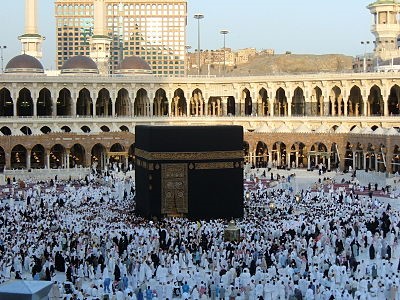A Glimpse into Hajj
An Unforgettable Journey

Located in Mecca, Kaaba is of incredible religious significance and marks the destination of the annual Islamic pilgrimage called Hajj.
Imagine a colossal cube made of granite, measuring 13.1 meters high, 11.03 meters long and 12.86 meters wide, the height of which is approximately equal to that of a seven-story building.
Kaaba, also referred to as the Black Stone, is probably the only construction that can match the picture in your head.
Located in Mecca, Saudi Arabia, Kaaba is of incredible religious significance and marks the destination of the annual Islamic pilgrimage called Hajj. During 2016’s Hajj, two million Muslims from more than 183 countries gathered in Mecca, dressed in all white, to pray.
Standing for a mandatory religious duty that all adult Muslims should carry out at least once during their lifetime, Hajj is a five-day trial. This year, it started on September 6 and came to a close on September 11.
Muslim culture believes participating in Hajj gives people firsthand experiences of the struggles, miseries, and sacrifices their ancestors went though. It is a cleansing process; all the pilgrims return home with God’s best blessings.
Mr. Johnson, Williston’s History and Religion teacher, said: “In practice, only nine percent of Muslims have the physical and financial means to afford it [Hajj].” Johnson said. “If they are so lucky, they can certainly experience firsthand the incredible diversity of Islam, and yet, feel a very real sense of unity of belief and purpose with the 1.5 billion Muslims around the world.”
Around the Hajj, there are a lot of interesting traditions. Mr. Rivenburgh, a history teacher at Williston, shared his favorites.
“The one I like the most is called stoning of the devil,” Rivenburgh said. “One of the steps is at a pillar where all Muslims throw stones towards this pillar in a symbolization of cursing Satan. They throw seven stones at each pillar. Seven seems to be a holy number in many religions.”
However, despite the religious significance, incredible diversity, and welcoming brotherhood, there also exist some controversies concerning Hajj.
During 2015’s Hajj, two large groups of pilgrims had a major crush in Mina, which caused the deaths of over one thousand people. This year, 14 deaths were reported due to the overcrowded situation.
The strict rules on Islamic women’ clothing and the general social constraints also caused heated discussions.
Johnson said, “I think the scholars generally agree that the lives of Arabian women improved dramatically with the rise of Islam in the 7th century. But from a Western perspective, the practices of some Muslims in the world today are troubling, especially for women. Even calling them Muslim practices is often misleading. This is because the line between religion and culture is often hard to draw.”
Johnson continued, saying, “I think that any religious practitioner who reads their ancient texts literally is likely to support practices that reflect and perpetuate the patriarchal and even misogynistic values that were common in the period during which the text was created. That is true of Muslims who read their texts literally, but it is also true of Jews, Christians, and other faiths as well.”
Though Johnson does not know anyone who has been to the Hajj, he cited Malcolm X, who wrote about attending the spiritual pilgrimage.
“In his retelling it,” Johnson said, “the aforementioned sense of unity and brotherhood really comes through.”
“Before the trip,” Johnson said, “[Malcolm X] regarded whites as essentially the enemy of the black man. Afterwards, there were potential allies in the fight for civil rights. It was a transformative experience that radically altered Malcolm X’s perspective on race.”
Shirley Zhou is a four-year senior at Williston. She is from Changshu, China. She enjoys listening to music, playing the guitar, and creative writing (preferably...












